1993 CHEVROLET CAMARO clutch
[x] Cancel search: clutchPage 62 of 358
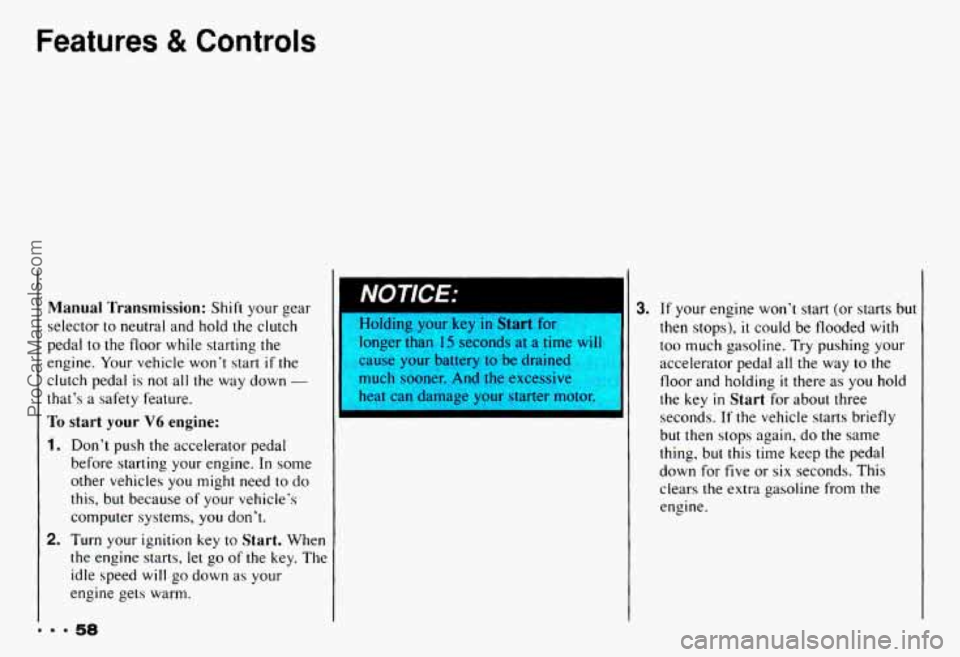
Features & Controls
Manual Transmission: Shift your gear
selector to neutral and hold the clutch
pedal
to the floor while starting the
engine. Your vehicle won’t start if the
clutch pedal
is not all the way down -
that’s a safety feature.
To start your V6 engine:
1. Don’t push the accelerator pedal
before starting your engine.
In some
other vehicles
you might need to do
this, but because of your vehicle’s
computer systems,
you don’t.
2. Turn your ignition key
to Start. When
the engine starts, let go
of the key. The
idle speed
will go down as your
engine gets warm.
NOTICE: 3. If your engine won’t start (or starts but
then stops),
it could be flooded with
too much gasoline. Try pushing your
accelerator pedal all the way
to the
floor and holding
it there as you hold
the
key in Start for about three
seconds.
If the vehicle starts briefly
but then stops again, do the same
thing, but
this time keep the pedal
down for five
or six seconds. This
clears the extra gasoline from the engine.
ProCarManuals.com
Page 70 of 358
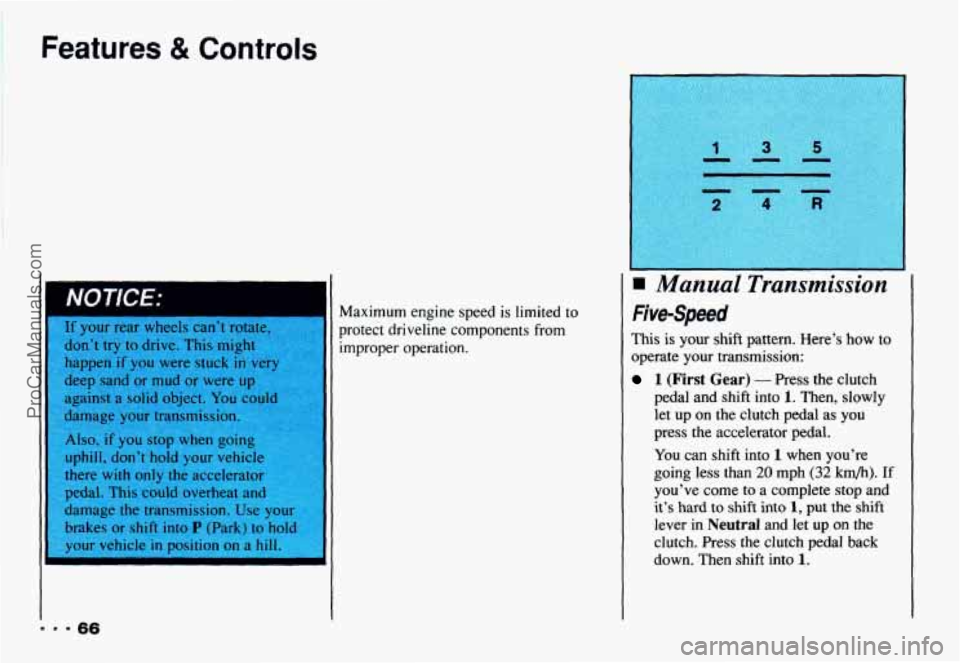
Features & Controls
r
If your rear wheels can’t rotat
don’t try to drive.
This might
happen if you were stuck
in v
deep sand or mud or were up
, , against a solid object. You
damage your transmission
Also, if you stop when goi
uphill, don’t hold your vehi
there
with only the accelerat
pedal. This could overheat an
damage the transmission.
Use your
brakes or shift into
P (Park) to hold
9.966
Maximum engine speed is limited to
protect driveline components from
improper operation.
Manual Transmission
Five-Speed
This is your shift pattern. Here’s how to
operate your transmission:
1 (First Gear) - Press the clutch
pedal and shift into
1. Then, slowly
let up on the clutch pedal as you
press the accelerator pedal.
You can shift into
1 when you’re
going less than
20 mph (32 km/h). If
you’ve come to a complete stop and
it’s hard to shift into
1, put the shift
lever in
Neutral and let up on the
clutch.
Press the clutch pedal back
down. Then shift into
1.
ProCarManuals.com
Page 71 of 358
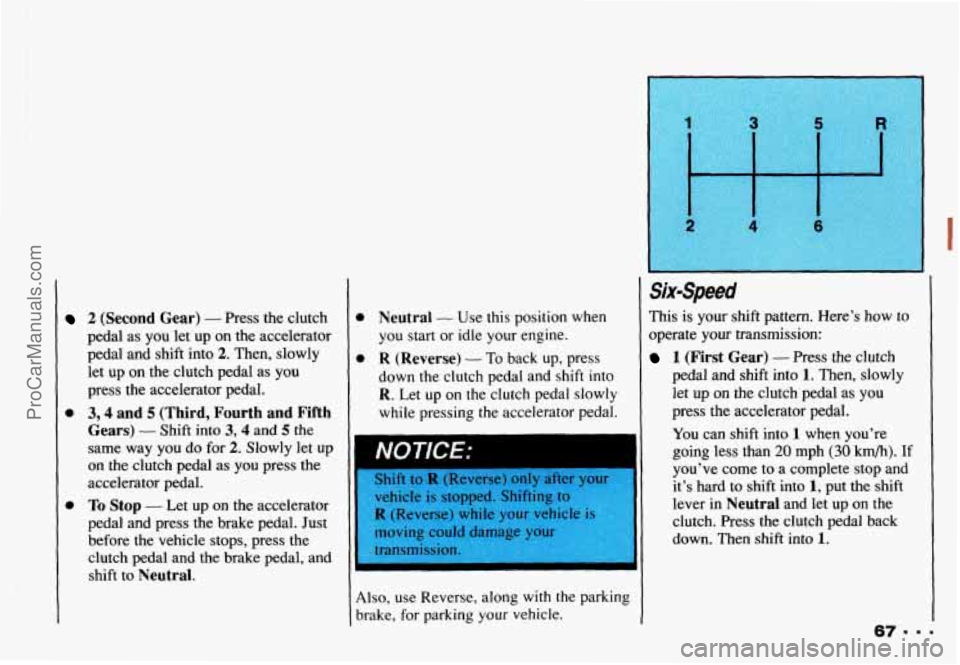
0
2 (Second Gear) - Press the clutch
pedal as you let up on the accelerator
pedal and shift into
2. Then, slowly
let up
on the clutch pedal as you
press
the accelerator pedal.
3,4 and 5 (Third, Fourth and Fifth
Gears)
- Shift into 3,4 and 5 the
same way
you do for 2. Slowly let up
on the clutch pedal as you press the
accelerator pedal.
To Stop - Let up on the accelerator
pedal and press the brake pedal. Just
before the vehicle stops, press the
clutch pedal and the brake pedal, and
shift to
Neutral.
0
0 Neutral - Use this position when
you start or idle your engine.
R (Reverse) - To back up, press
down the clutch pedal and shift into
R. Let up on the clutch pedal slowly
while pressing the accelerator pedal.
m-
- ~~
NOTICE:
Shift to K (Reverse) only atter your
vehicle is stopped. Shifting to
R (Reverse) while your vehicl
moving could darnage-pur
transmission. .I :.: , .. , LC.; 96’ b~ ,.? * ., )I
Also, use Reverse, along with the parking
brake, for parking your vehicle.
Six-Speed
This is your shift pattern. Here’s how to
operate your transmission:
1 (First Gear) - Press the clutch
pedal and shift into
1. Then, slowly
let up on the clutch pedal as you
press the accelerator pedal.
You can shift into 1 when you’re
going less than
20 mph (30 km/h). If
you’ve come to a complete stop and
it’s hard to shift into
1, put the shift
lever in
Neutral and let up on the
clutch. Press the clutch pedal back
down. Then shift into
1.
I
ProCarManuals.com
Page 72 of 358
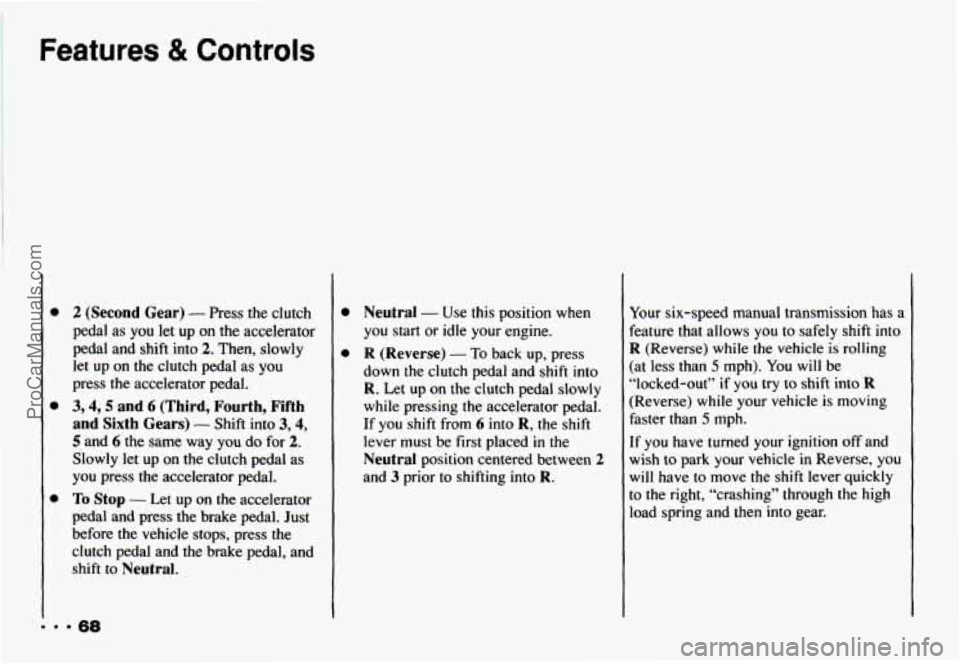
Features & Controls
0
0
0
2 (Second Gear) - Press the clutch
pedal as you let up on the accelerator
pedal and shift into
2. Then, slowly
let up on the clutch pedal as you
press the accelerator pedal.
3,4,S and 6 (Third, Fourth, Fifth
and Sixth Gears)
- Shift into 3,4,
5 and 6 the same way you do for 2.
Slowly let up on the clutch pedal as
you press the accelerator pedal.
To Stop - Let up on the accelerator
pedal and press
the brake pedal. Just
before the vehicle stops, press the
clutch pedal and the brake pedal, and
shift to
Neutral. Neutral
- Use this position when
you start or idle your
engine.
R (Reverse) - To back up, press
down the clutch pedal and shift into
R. Let up on the clutch pedal slowly
while pressing the accelerator pedal.
If
you shift from 6 into R, the shift
lever must be first placed
in the
Neutral position centered between 2
and 3 prior to shifting into R.
Your six-speed manual transmission has a
feature that allows you to safely shift into
R (Reverse) while the vehicle is rolling
(at less than
5 mph). You will be
“locked-out”
if you try to shift into R
(Reverse) while your vehicle is moving
faster than
5 mph.
If
you have turned your ignition off and
wish to park your vehicle
in Reverse, you
will have to move the shift lever quickly
to the right, “crashing” through the high
load spring and then into gear.
ProCarManuals.com
Page 73 of 358
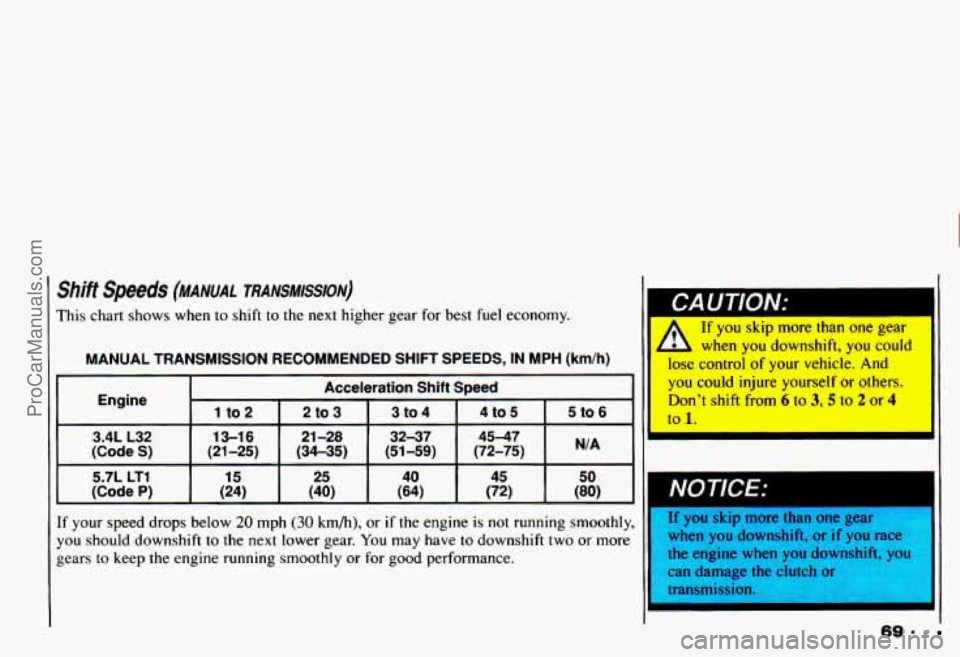
shift speeds (MANUAL TRANSMISSION)
This chart shows when to shift to the next higher gear for best fuel economy. , If you skip more than one gear I
-‘L when youdownshift, you could MANUAL TRANSMISSION RECOMMENDED SHIFT SPEEDS, IN MPH (km/h) , , lose control of your vehicle. And I
-
Engine
3.4L L32 13-16
I (Code S) I (21-25)
5.7L LT1 (24)
(Code P)
15
Acceleration Shift Speed you could injure yourself or others.
Don’t shift from
6 to 3, 5 to 2 or 4 2 to 3
(72-75) (51
-59) (34-35) 4547
32-37
21 -28
5 to 6 4 to 5
3 to 4
N/A
25 50 45 40
-
(40) (80) (72)
(64)
If your speed drops below 20 mph (30 km/h), or if the engine is not running smoothly,
you should downshift to the next lower gear. You may have to downshift two
or more
gears to keep the engine running smoothly or for
good performance.
NOTICE:
If you skip more than one gear
when
you downshift, or if you race
the engine when you downshift, you
can damage
the clutch or
transmission.
I- -1 I I
69..
ProCarManuals.com
Page 84 of 358
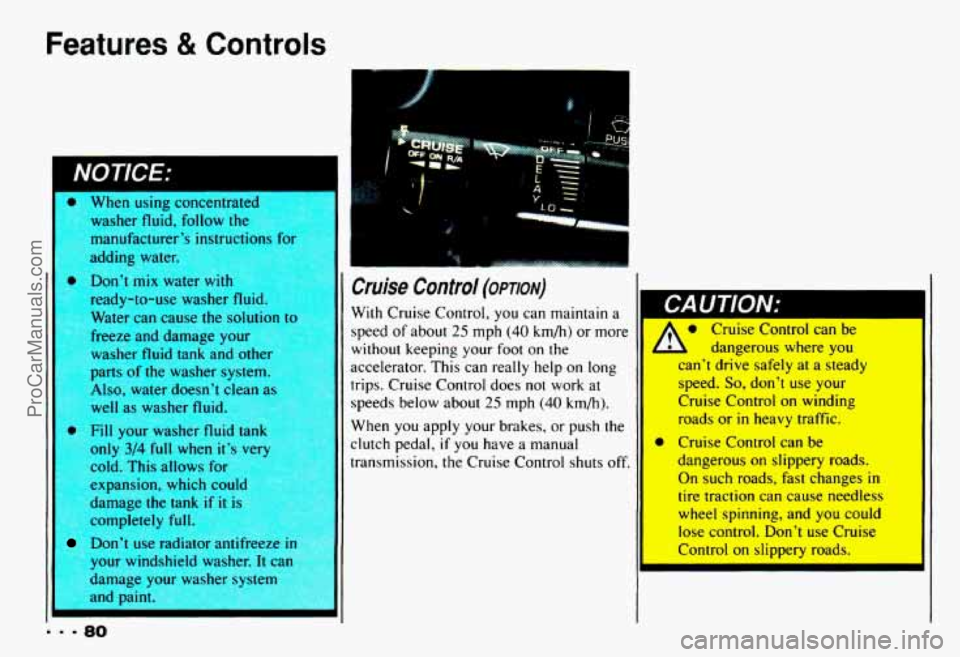
Features & Controls
II
washer fluid, follow the
manufacturer’? instructiopc
fnr
adding water.
Don’t mix warGI with
ready-to-use washer
fluic..
Water can cause the solutinn tn
freeze and damage your
washer
fluid tank and other
parts of the washer systen
Also, water doesn’t clean as
well as washer fluid.
Fill your washer fluid tank
only
3/4 full when it’s ver
cold. This allows
fo
expansion, which COUI(
damage the tank if it is
completely full.
Don’t use radiator anurreeze In
your windshield washer. It can
and paint. damage yolw
wacher cvctpm
-=-8O I
Cruise Control (opmv)
With Cruise Control, you can maintain a
speed of about
25 mph (40 km/h) or more
without keeping your foot on the
accelerator. This can really help on long
trips. Cruise Control does not work
at
speeds below about 25 mph (40 km/h).
When
you apply your brakes, or push the
clutch pedal,
if you have a manual
transmission, the Cruise Control shuts off.
Cruise Control can be
1 L dangerous where you
can’t drive safely at a steady
speed.
So, don’t use your
Cruise Control
on winding
roads or
in heavy traffic.
dangerous
on slippery roads.
On such roads, fast changes in
tire traction can cause needless
wheel spinning, and you
could
lese control. hn’t use Cruise
* Cruise Control can be
ProCarManuals.com
Page 88 of 358

Features & Controls
I
I
I'o Get Out of Cruise Control
There are several ways to turn off the
Cruise Control:.
1. Step lightly on the brake pedal or push
the clutch pedal,
if you have a manual
transmission:
OR
2. Move the Cruise switch to OFF.
To Erase Speed Memory
When you turn off the Cruise Control or
the ignition, your Cruise Control set speed
memory
is erased.
Operation of Lights
Although your vehicle's lighting system
(headlights, parking lights,
fog lamps,
side marker lights and taillights) meet all
applicable federal lighting requirements,
certain states and provinces may apply
their own lighting regulations that may
require special attention before you
operate these lights. For example, some
jurisdictions may require that
you operate
your lower beam lights with fog lamps at
all times, or that headlights be turned on
whenever you must use your windshield
wipers.
In addition, most jurisdictions
prohibit driving solely with parking
lights, especially at dawn or dusk. It is
recommended that you check with your
own state or provincial highway authority
for applicable lighting regulations.
ProCarManuals.com
Page 221 of 358

Part b
Here you will find information
about the care
of your Chevrolet .
This part begins with service and
fuel information. and then it shows
how
to check important fluid and
lubricant levels
. There is also
technical information about your
vehicle. and a section devoted to
its appearance care
.
Service & Appearance Care
Service .......................................................... 218
Fuel
............................................................ 219
Checking Things under the Hood
..................................... 223
HoodRelease
................................................... 223
Engineoil
...................................................... 226
Aircleaner
..................................................... 230
Automatic Transmission Fluid
...................................... 233
Manual Transmission Fluid
........................................ 235
Hydraulicclutch
................................................ 237
RearAxle
...................................................... 237
Enginecoolant
.................................................. 238
Power Steering Fluid
............................................. 242
Windshield Washer Fluid
.......................................... 243
Brake Master Cylinder
............................................ 244
Battery
........................................................ 246
Bulb Replacement
................................................. 247
Loading Your Vehicle
.............................................. 255
Appearance Care and Maintenance Materials
............................ 274
Vehicle Identification Number (VIN)
.................................. 275
Service Parts Identification Label
..................................... 275
Add-on Electrical Equipment
........................................ 275
Fuses and Circuit Breakers
.......................................... 276
Replacement Bulbs
................................................ 279
Capacities and Specifications
......................................... 280
Tires
............................................................ 256
Appearancecare
.................................................. 265
217
ProCarManuals.com